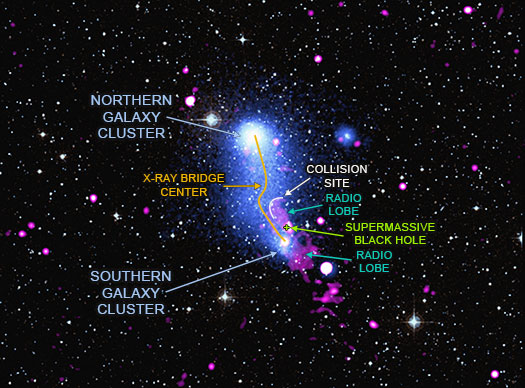X-ray and radyo observation of kalawakan system Abell 2384 reveals collision of two kalawakan clusters that travelled through each other forming a binodal system with a bridge of superhot gas between two cluster lobes and a bend in the bridge due to powerful jet of hot gas shooting away from a super heavy blackhole in the centre of a kalawakan sa kumpol.
To put the whole thing in a perspective, the earth along with other planeta and their satellites are part of the ‘stellar system’ of a bituin called sun. Each bituin may have such a system comprising of bodies orbiting them. Large number of bituin bound together by gravity form a celestial entity called kalawakan. For example, our solar system is part of a kalawakan called ‘milky way’ which alone has about 100 thousand million bituin, each with their own stellar system. Hundreds of galaxies bound together by gravitational field form what we call ‘kalawakan cluster’.
'kalawakan clusters’ are the largest objects in the sansinukob, each comprising of hundreds of galaxies together with vast amount of super-hot gas cloud and large amount of dark matter. The interspersed superhot (30 – 100 million degrees Celsius) gas cloud is invisible to optical telescope but emits x-rays observable by the x-ray telescope. The dark matter does not emit, absorb or reflect any electro-magnetic radiation hence is not observable by any kind of telescope, but only by their gravitational interaction with the ‘white’ matter.
Several hundred million years ago, at a distance of about 1.2 billion light years away from us, two kalawakan clusters collided and travelled through each other forming a merger-like system called Abell 2384 or A2384. Located in the constellation capricornus (one of the constellations of Zodiac and is known as ‘goat horn’), Abell 2384 is about 17 million light years across in size with two unequal cluster lobes connected by a three million light-year long bridge of hot gas.
Mga astronomo nakakuha ng detalyadong composite view nito kalawakan sistema ng kumpol, Abell 2384 gamit ang multi-wavelength na data mula sa tatlong magkakaibang uri ng mga pinagmumulan na binanggit sa ibaba:
1. Asul: Data ng X-ray mula sa Chandra X-Ray Observatory (X-ray puwang telescope launched by NASA in 1999) and XMM-Newton (X-ray puwang observatory launched by the European Space Agency in 1999).
2. Magenta: radyo data from provided by Giant Metre-wave Radio Telescope (GMRT), India.
3. Yellow: Optical data from Digitized Sky Survey (DSS) by Puwang Telescope Science Institute.
The x-ray data obtained from the puwang observatories revealed high-density region extended between the two cluster heads corresponding to the unique hot gas bridge. Radio observation indicated x-ray-radio interaction at the cluster outskirts indicative of a peculiar radio galaxy. The conclusion is that of a powerful jet shooting away from a supermassive Black hole in the centre of a galaxy within the galaxy cluster leading to bend in the shape of the gas bridge.
Ang pag-aaral na ito ay makabuluhan para sa pagbuo ng base ng kaalaman tungkol sa paglago at kurso ng pagsasanib ng kalawakan clusters in the sansinukob. Simulation suggests that the north and south clusters in the system Abell 2384 will eventually merge together with each other.
***
Pinagmumulan:
1. United space in Europe (European Space Agency) 2020. Isang baluktot na tulay sa pagitan ng dalawang kumpol ng kalawakan. Post 11 May 2020. Available online sa http://www.esa.int/Science_Exploration/Space_Science/A_bent_bridge_between_two_galaxy_clusters Na-access noong 13 Mayo 2020.
2. Chandra X-Ray Observatory (NASA) 2020. Abell 2384: Bending the Bridge Between Two Galaxy Clusters. Petsa ng Paglabas: Mayo 11, 2020. Available online sa https://chandra.si.edu/photo/2020/a2384/index.html Na-access noong 13 Mayo 2020.
3. Parekh V., Lagana TF, et al., 2020. Isang bihirang kaso ng pakikipag-ugnayan ng FR I sa isang mainit na X-ray bridge sa A2384 galaxy cluster. MNRAS 491, 2605–2616. DOI: https://doi.org/10.1093/mnras/stz3067
***






































